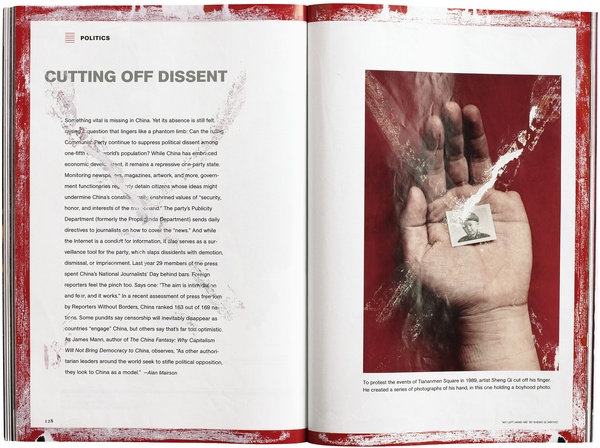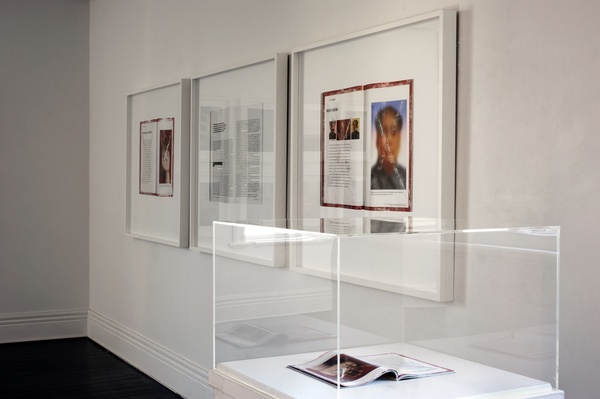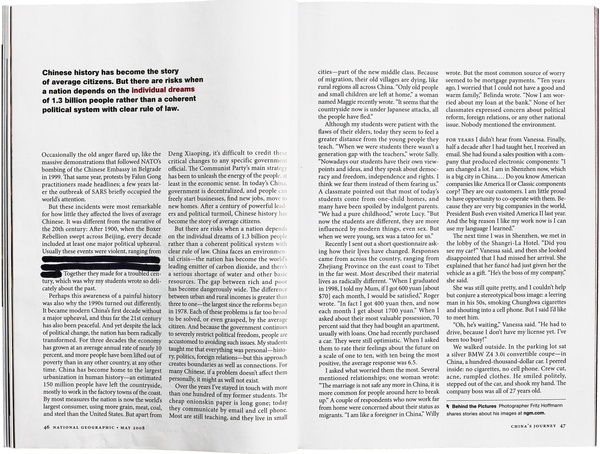briefs
2017-03-29
Censored

While at Melbourne’s National Gallery of Victoria a week or so ago ...
While at the National Gallery of Victoria a week or so ago for the corker Melbourne Art Book Fair, I wandered the gallery and found amongst their collection the Sheng Li series ‘Memories’, the photographs of his cut off finger, a protest against the 1989 events of Tiananmen Square.
In China not long before their Olympics, while working on ‘I Must Behave’, I bought a sealed copy of the May 2008 National Geographic magazine, a special pre-Olympic Games issue on China, which included one image from this Sheng Li series, although taken at a slightly different angle from the one hanging in the NGV.
I wrote the commentary below for GRANTA (105, Lost and Found, Spring 2009) when the magazine published my three-panel ‘Censored’ work recontextualizing three, censored, double-page spreads from this National Geographic issue.
The three panels were collected by the National Gallery of Australia in 2014.

LAST SPRING, on my way back to New Zealand from Dubrovnik, I stopped over in Hong Kong and took a ferry from the airport, up the Pearl River Delta to Zhongshan, a small (by Chinese standards), agreeable city in Guangdong province. It was friends of friends in Zhongshan who loaned me their subscription copy of National Geographic, a special, pre-Olympic Games issue on China, which I had returned after a few days. I decided to buy a copy of my own. I found one in Zhongshan’s chief bookstore, upstairs in Holiday Plaza. It appeared to be the only English-language magazine in a well-stocked shop. It was sealed in polythene.
Back at my hotel, I took off the wrapping and started to flip through it. On page forty-six, I stopped. Two and a bit lines on the left-hand page had been crossed out in heavy black ink. Censored, I deduced—it was not long until the Olympic Games. Everywhere else in the world people were discussing whether the Games would provoke change in the Chinese government, but China is China.
And this was National Geographic. Why would any government want to censor such a normally uncontroversial magazine, even the Chinese government? It was true, however, that when I tilted the page, I could just make out what was underneath the black ink: ‘... the Japanese invasion to the Cultural Revolution to the massacre around Tiananmen Square in 1989’. So this was an unusually provocative piece for National Geographic.
Then the censor had twice drawn his or her glue-stick diagonally across the page in a neat, symbolic cross ...
I carried on, and soon came to a page that felt thicker and stiffer than the others. At first I assumed it was a three-page foldout, but then I realized that two pages had been completely glued together. Further on, I found two more double-page spreads that were glued together and spent nearly an hour carefully prising them apart. They had been stuck around the red border of each page, which might have been made for the task. Then the censor had twice drawn his or her glue-stick diagonally across the page in a neat, symbolic cross that, when I tried to peel the pages apart, tore at the ink, ensuring whatever had been written there was lost forever and immortalizing the censor’s work.

I examined what lay beneath. On one spread, under the headline minorities, was a map of China with each minority assigned its own colour: the problem must have been that Taiwan, which China claims as part of its territory, was colourless. A second spread, ‘Mao Now’, showed four works by Chinese artists, each depicting Mao. One of these, Gao Qiang's ‘Swimming Mao’, according to National Geographic, ‘was banned’. A third spread, with the title ‘Cutting Off Dissent’, presented a full-page artwork by Sheng Qi - a photograph of his left hand cradling a ‘boyhood’ photograph, which showed his missing little finger, which he had cut off in protest at the Tiananmen Square massacre in 1989.
Had the censor been in China, or in America? The magazine was turning out to be a collector’s item. I admit: I returned to the bookstore and bought another copy in its polythene wrapper, which remains sealed. Back home, I made a few enquiries. I found only one reference online, but it proved I wasn’t the only person to have bought a censored copy. At National Geographic, the director of media relations confirmed what I pretty much knew: ‘someone connected with local magazine distribution in Asia glued together a few pages of the May 2008 issue’. It was an isolated incident, and there had been no official or unofficial communication about it. ‘It does happen occasionally in some countries that distributors feel they need to take local sensibility into account.’ It was a hazard of global sales.

Mulling over the layers of art and politics involved, I realized I had unwittingly prepared an artwork of my own, right there in the Louis Hotel. I had three of the spreads photographed to produce a political triptych (Censored 2008), three large pigment prints each twice the size of a National Geographic double-page spread; my personal recontextualization of these pages.
BRUCE CONNEW / 04.2009